
How to Use XIAO ESP32C3: Examples, Pinouts, and Specs
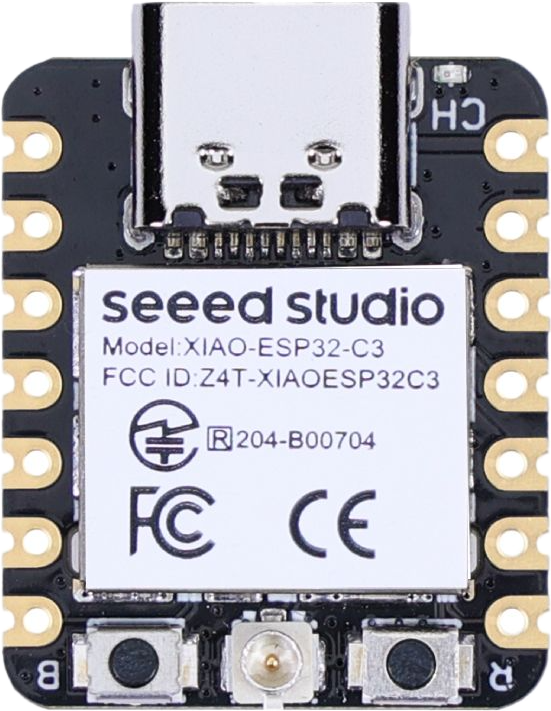
 Design with XIAO ESP32C3 in Cirkit Designer
Design with XIAO ESP32C3 in Cirkit DesignerIntroduction
The XIAO ESP32C3 by Seeed Studio is a compact and powerful microcontroller board based on the ESP32-C3 chip. It features built-in Wi-Fi and Bluetooth Low Energy (BLE) capabilities, making it an excellent choice for Internet of Things (IoT) projects, smart devices, and wireless communication applications. Its small form factor and low power consumption make it ideal for portable and space-constrained designs.
Explore Projects Built with XIAO ESP32C3
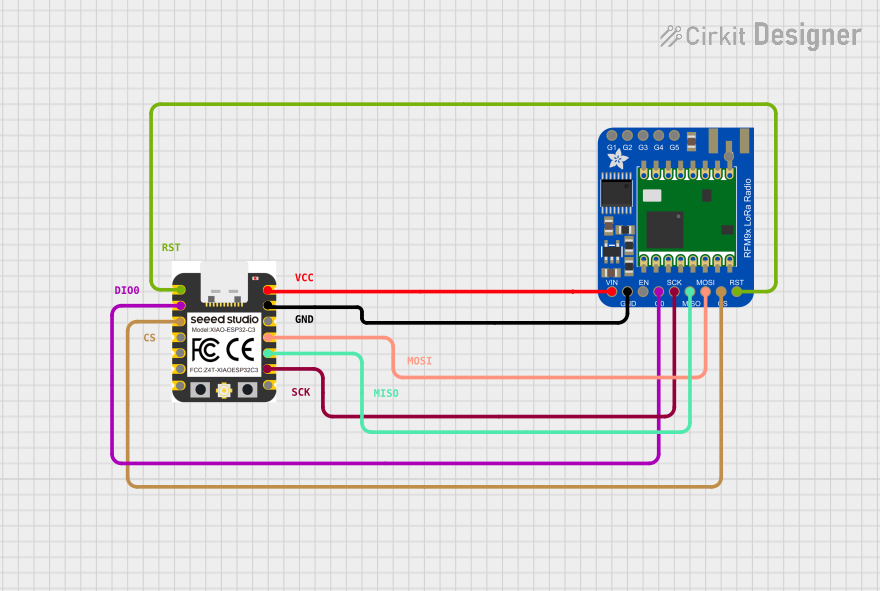
 Open Project in Cirkit Designer
Open Project in Cirkit Designer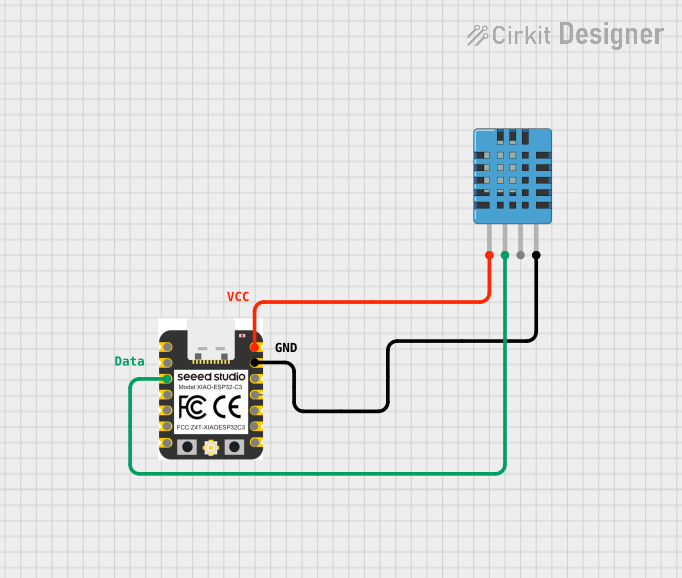
 Open Project in Cirkit Designer
Open Project in Cirkit Designer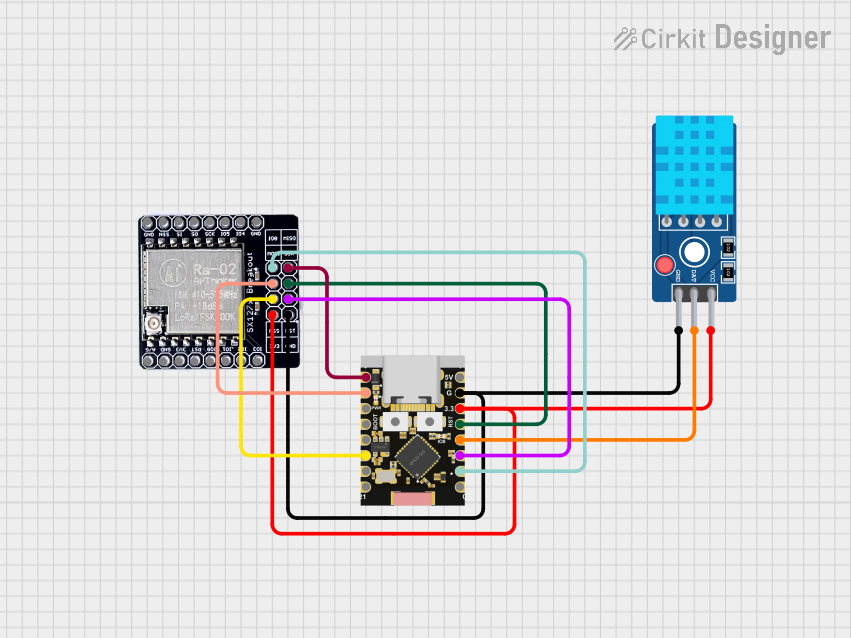
 Open Project in Cirkit Designer
Open Project in Cirkit Designer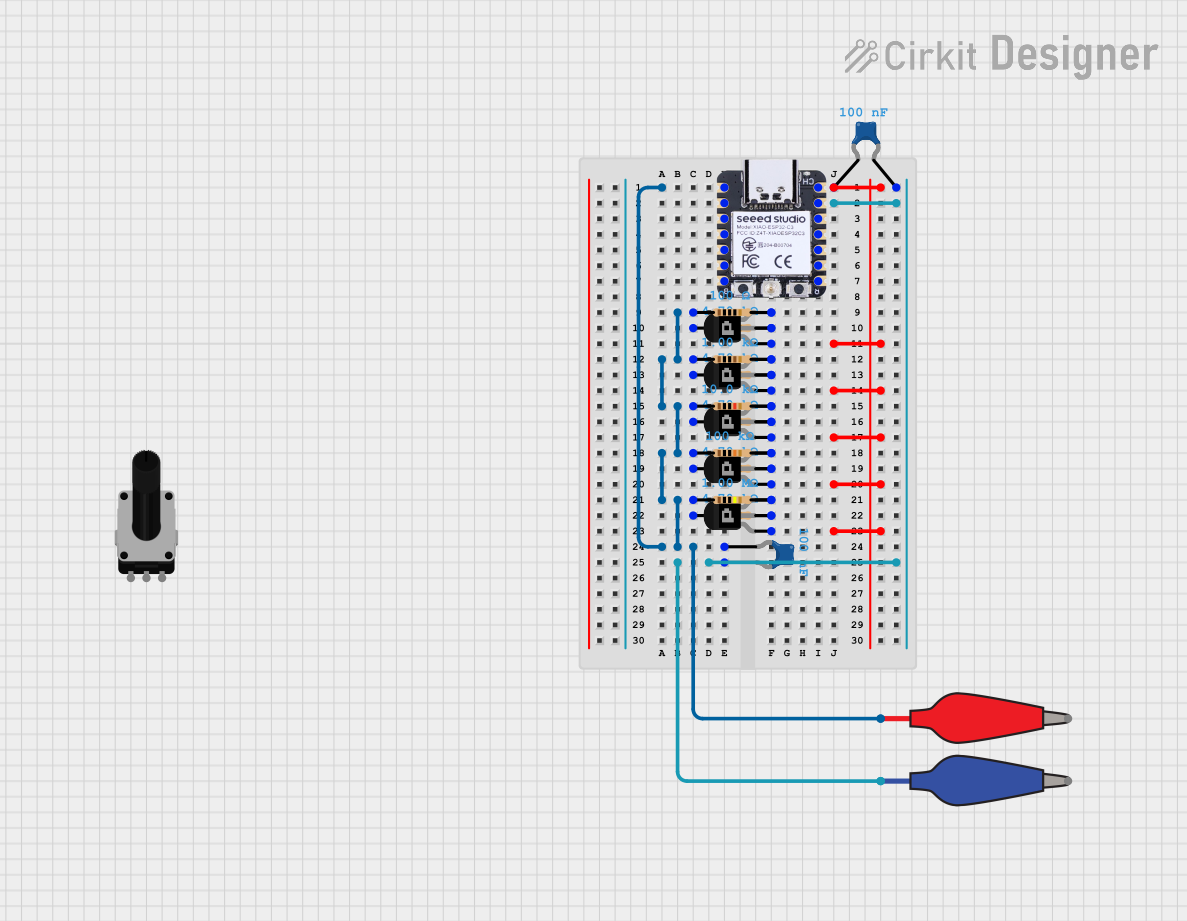
 Open Project in Cirkit Designer
Open Project in Cirkit DesignerExplore Projects Built with XIAO ESP32C3

 Open Project in Cirkit Designer
Open Project in Cirkit Designer
 Open Project in Cirkit Designer
Open Project in Cirkit Designer
 Open Project in Cirkit Designer
Open Project in Cirkit Designer
 Open Project in Cirkit Designer
Open Project in Cirkit DesignerCommon Applications and Use Cases
- IoT devices and smart home automation
- Wireless sensor networks
- Wearable technology
- Remote monitoring and control systems
- Prototyping for Wi-Fi and BLE-enabled devices
Technical Specifications
Below are the key technical details of the XIAO ESP32C3:
| Specification | Details |
|---|---|
| Microcontroller | ESP32-C3 RISC-V single-core processor |
| Clock Speed | Up to 160 MHz |
| Flash Memory | 4 MB |
| SRAM | 400 KB |
| Wireless Connectivity | Wi-Fi 802.11 b/g/n (2.4 GHz), Bluetooth 5.0 BLE |
| Operating Voltage | 3.3V |
| Input Voltage Range | 5V (via USB-C) |
| GPIO Pins | 11 (including ADC, PWM, I2C, SPI, UART) |
| USB Interface | USB-C (supports programming and power supply) |
| Dimensions | 21 x 17.5 mm |
| Power Consumption | Ultra-low power consumption in deep sleep mode |
| Operating Temperature | -40°C to 85°C |
Pin Configuration and Descriptions
The XIAO ESP32C3 has 11 GPIO pins, which are multifunctional and can be configured for various purposes. Below is the pinout description:
| Pin | Function | Description |
|---|---|---|
| 0 | GPIO0, ADC, PWM | General-purpose I/O, Analog-to-Digital Converter, Pulse Width Modulation |
| 1 | GPIO1, ADC, PWM | General-purpose I/O, Analog-to-Digital Converter, Pulse Width Modulation |
| 2 | GPIO2, ADC, PWM | General-purpose I/O, Analog-to-Digital Converter, Pulse Width Modulation |
| 3 | GPIO3, ADC, PWM | General-purpose I/O, Analog-to-Digital Converter, Pulse Width Modulation |
| 4 | GPIO4, ADC, PWM | General-purpose I/O, Analog-to-Digital Converter, Pulse Width Modulation |
| 5 | GPIO5, UART TX, PWM | General-purpose I/O, UART Transmit, Pulse Width Modulation |
| 6 | GPIO6, UART RX, PWM | General-purpose I/O, UART Receive, Pulse Width Modulation |
| 7 | GPIO7, I2C SDA, PWM | General-purpose I/O, I2C Data Line, Pulse Width Modulation |
| 8 | GPIO8, I2C SCL, PWM | General-purpose I/O, I2C Clock Line, Pulse Width Modulation |
| 9 | GPIO9, SPI MOSI, PWM | General-purpose I/O, SPI Master Out Slave In, Pulse Width Modulation |
| 10 | GPIO10, SPI MISO, PWM | General-purpose I/O, SPI Master In Slave Out, Pulse Width Modulation |
Usage Instructions
How to Use the XIAO ESP32C3 in a Circuit
Powering the Board:
- Use a USB-C cable to connect the XIAO ESP32C3 to your computer or a 5V power source.
- The board operates at 3.3V internally, so ensure external components are compatible with this voltage.
Programming the Board:
- Install the Arduino IDE and add the ESP32 board package via the Board Manager.
- Select "Seeed XIAO ESP32C3" as the target board.
- Connect the board via USB-C and upload your code.
Connecting Peripherals:
- Use the GPIO pins for interfacing with sensors, actuators, or other devices.
- Ensure proper pin configuration in your code (e.g., setting pins as input or output).
Wireless Communication:
- Use the built-in Wi-Fi and BLE capabilities for wireless data transmission.
- Libraries such as
WiFi.handBLEDevice.hcan simplify development.
Important Considerations and Best Practices
- Voltage Levels: Avoid applying voltages higher than 3.3V to the GPIO pins to prevent damage.
- Deep Sleep Mode: Utilize the deep sleep mode for battery-powered applications to conserve energy.
- Antenna Placement: Ensure the onboard antenna is not obstructed by metal objects to maintain optimal wireless performance.
- Firmware Updates: Regularly update the ESP32-C3 firmware to benefit from the latest features and bug fixes.
Example Code for Arduino UNO Integration
Below is an example of using the XIAO ESP32C3 to connect to a Wi-Fi network and send data to a server:
#include <WiFi.h> // Include the Wi-Fi library
// Replace with your network credentials
const char* ssid = "Your_SSID";
const char* password = "Your_PASSWORD";
void setup() {
Serial.begin(115200); // Initialize serial communication
delay(1000);
// Connect to Wi-Fi
Serial.print("Connecting to Wi-Fi");
WiFi.begin(ssid, password);
while (WiFi.status() != WL_CONNECTED) {
delay(500);
Serial.print(".");
}
Serial.println("\nConnected to Wi-Fi!");
}
void loop() {
// Check Wi-Fi connection status
if (WiFi.status() == WL_CONNECTED) {
Serial.println("Wi-Fi is connected!");
} else {
Serial.println("Wi-Fi is not connected!");
}
delay(5000); // Wait for 5 seconds before checking again
}
Troubleshooting and FAQs
Common Issues and Solutions
The board is not detected by the computer:
- Ensure the USB-C cable supports data transfer (not just charging).
- Check if the correct drivers are installed for the XIAO ESP32C3.
Wi-Fi connection fails:
- Verify the SSID and password are correct.
- Ensure the Wi-Fi network operates on the 2.4 GHz band (not 5 GHz).
Code upload fails:
- Double-check the selected board and port in the Arduino IDE.
- Press the reset button on the board before uploading.
GPIO pins not working as expected:
- Confirm the pin mode is correctly set in the code (e.g.,
pinMode(pin, OUTPUT)). - Check for short circuits or incorrect wiring.
- Confirm the pin mode is correctly set in the code (e.g.,
FAQs
Can the XIAO ESP32C3 be powered by a battery?
Yes, it can be powered by a 3.7V LiPo battery connected to the 3.3V and GND pins.Does the board support OTA (Over-The-Air) updates?
Yes, the ESP32-C3 chip supports OTA updates, which can be implemented using the appropriate libraries.What is the maximum range of the Wi-Fi and BLE?
The range depends on environmental factors but typically reaches up to 30 meters indoors and 100 meters outdoors.Can I use the XIAO ESP32C3 with MicroPython?
Yes, the board supports MicroPython, and you can flash the firmware to use it.